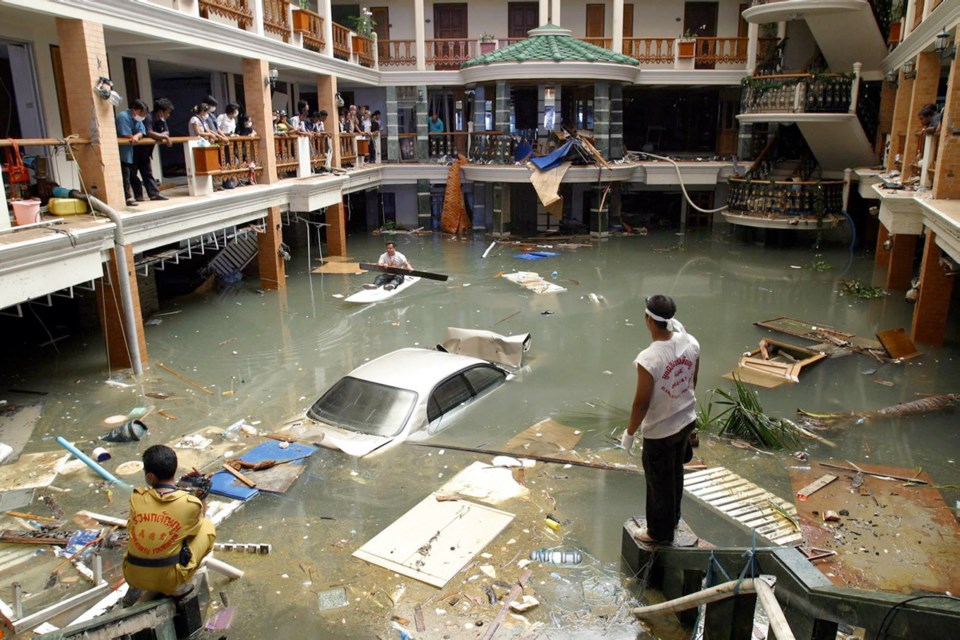In the photo, taken just days after one of the deadliest tsunamis in history hit Southeast Asia, emergency workers search for bodies in a flooded hotel lobby, debris floating alongside cars.
Ten years later, the scene remains one of the most memorable for Tofino resident Deddeda White, who was a photojournalist in Thailand documenting the immediate aftermath of the Boxing Day disaster.
“It was quite a surreal scene to go into. I’ve never witnessed anything like that before,” White said of the days she spent wandering the area around Patong Beach in southern Thailand. “There were dead bodies everywhere.”
Few people understood the devastating capacity of tsunamis before the 2004 disaster. Waves as tall as buildings rolled into coastal communities in 14 countries, flattening entire villages and claiming the lives of about 250,000 people. Since then, global warning systems have expanded, but vulnerabilities still exist at the local level.
For White, the first indication that something major had occurred were TV reports of an earthquake off Sumatra. The former Times Colonist photographer, whose surname at the time was Stemler, was snorkeling with her partner and fellow photojournalist Sean White on the east coast of Thailand, which was not affected by the disaster.
They booked flights to Phuket, a popular tourist destination, immediately. “I felt compelled to go, we were so close,” she said. “We made the decision to leave the next morning and cover it.”
Only a handful of other passengers were on the plane. When they asked a taxi driver to take them to Patong Beach, he twice tried to turn around.
“People were trying to flee,” White said. “They had already been hit by three waves, so it was pandemonium and panic.”
White spent her days at Patong Beach documenting the damage: cars crushed into hotel lobbies, sea life plastered onto building facades four storeys high. She visited eight or nine hospitals, which were being used as treatment centres for the injured, morgues for the dead and information centres for those looking for missing people.
When she was asked to return to work in Canada a few days later, she was devastated by the knowledge that some powerful images would go undocumented.
“No one understood the scale of how many people died that day. It was heart-wrenching,” she said.
Photographs like White’s gave people around the world a new understanding the threat posed by tsunamis, said Garry Rogers, an earthquake scientist based in Sidney.
Media coverage and camera phones meant people saw the devastation in an unprecedented way, emboldening politicians and citizens to call for an expanded global alert system.
As the Canadian representative to UNESCO’s Pacific tsunami warning system, Rogers has watched the alert system grow.
“I’ve seen it evolve from just a Pacific system that wasn’t as immediate as it is now, to a very effective system,” Rogers said. “And it’s largely because of that particular tsunami and the way visual media did a very good job of telling people.”
When the magnitude-9.1 earthquake hit in 2004, scientists knew immediately that a pulse of waves were headed to places like Indonesia, Sri Lanka and Thailand. But there was no formal way to warn them, since the alert system was limited to the Pacific Ocean, Rogers said. The problem was exacerbated by the fact that many people were on holiday.
“They didn’t know who to send the message to — they weren’t responsible for the Indian Ocean,” Rogers said.
Now there’s a system that issues tsunami warnings in every ocean of the world. There are 101 sea-level gauges, 148 seismometers and nine buoys in the Indian Ocean system. Vancouver Island has about 30 monitoring stations.
But significant vulnerabilities still exist at the local level, Rogers said. There’s a need for more public education, so that people will know what to do as soon as they feel prolonged shaking or see the ocean recede.
“If you’re in a coastal region and you feel strong shaking, get the hell out of there and head for high ground,” he said. “If all of a sudden the water drops and the tide goes out, don’t go out and pick up the fish. There were several people on the Indian Ocean who died because that’s exactly what they did.”
The other lesson is that a tsunami is not one wave, but a series of waves, he said, noting that waves can continue for up to 24 hours.
White, who lives in the tsunami zone of Tofino, is bothered by how little information is available to tourists visiting the area. She worries the town’s two sirens won’t be enough.
“It’s scary,” she said. “I just know if a tsunami hit Tofino or anywhere else on the West Coast, there would be a huge loss of life. It’s hard to imagine what communities could actually do to prepare, but I think there has to be more education.”



